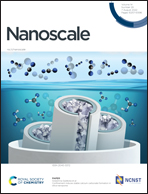Confinement induces stable calcium carbonate formation in silica nanopores†
Abstract
Scalable efforts to remove anthropogenic CO2via the formation of durable carbonates require us to harness siliceous nanoporous geologic materials for carbon storage. While calcium carbonate formation has been extensively reported in bulk fluids, there is a limited understanding of the influence of nanoconfined fluids on the formation of specific stable and metastable polymorphs of calcium carbonates in siliceous materials that are abundant in subsurface environments. To address this challenge, silica nanochannels with diameters of 3.7 nm are architected and the formation of specific calcium carbonate phases is investigated using X-ray diffraction (XRD), and molecular dynamics (MD) simulations. The formation of stable calcium carbonate (or calcite) is noted in silica nanochannels. The presence of fewer water molecules in the first hydration shell of calcium ions in confinement compared to in bulk fluids contributes to stable calcium carbonate formation. These studies show that nanoporous siliceous environments favor the formation of stable calcium carbonate formation.

- This article is part of the themed collection: CO2 capture and conversion


 Please wait while we load your content...
Please wait while we load your content...
